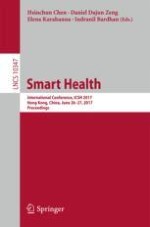2017 | Buch
Smart Health
International Conference, ICSH 2017, Hong Kong, China, June 26-27, 2017, Proceedings
herausgegeben von: Hsinchun Chen, Prof. Daniel Dajun Zeng, Elena Karahanna, Indranil Bardhan
Verlag: Springer International Publishing
Buchreihe : Lecture Notes in Computer Science
